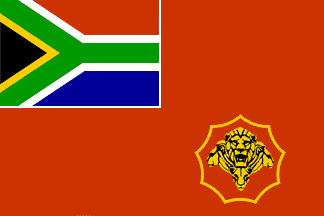 image by Zoltan Horvath, 3 Oct 2024
image by Zoltan Horvath, 3 Oct 2024
Last modified: 2025-05-24 by bruce berry
Keywords: army | castle | springbok |
Links: FOTW homepage |
search |
disclaimer and copyright |
write us |
mirrors
 image by Zoltan Horvath, 3 Oct 2024
image by Zoltan Horvath, 3 Oct 2024
At a Retreat ceremony held on Friday 25 April 2003, the old
South African National Defence Force (SANDF) emblem, based on the Cape Castle outline,
was formally phased out. The old SANDF flag was lowered at the South African Air Force Gymnasium Parade Ground at 18h00. The new SANDF
emblem and flags were presented at a parade presided over by the Chief of the South African National Defence Force, General Siphiwe Nyanda, on
29 April 2003 at Defence Force Headquarters at Thaba Tshwane (formerly known as
Voortrekkerhoogte) near Pretoria.
The change is another milestone in the transformation process in the SANDF and sees the replacement of the
Cape Castle outline with a new
emblem. The new SANDF emblem incorporates a nine-pointed "Star" representing the warm sun of Africa and the nine provinces of
South Africa. The Star outline replaces the Castle outline and is also used in divisional emblems and flags to reflect a common corporate
identity coupled with a unique device for each Division. The four Services retain their respective traditional colours. The emblem also
reinforces the idea of military identity, authority and dignity.
With the exception of the badge in the fly, the new Army flag is identical in colour and overall design to its immediate predecessor (the
fifth adopted by the South African Army), which had been in use between
April 2002 and 25 April 2003. The 2002-2003 Army flag was the first to use new emblem comprising a lion's head surrounded by three lionesses
heads (the so-called "pride of lions") in gold in the centre of a red
shield in place of the Springbok head.
ay03.gif) image by Martin
Grieve, 10 Feb 2004
image by Martin
Grieve, 10 Feb 2004
A new badge for the Army comprises the new nine-pointed star outline in yellow and in the centre
of which is army emblem of a lion's head surrounded by three lionesses' heads, also in yellow. The emblem is in the lower fly of the new Army
flag which was officially taken into use at a Defence Force parade held at Thaba Tshwane
near Pretoria on 29 April
2003.
Bruce Berry, 09 Jan 2004
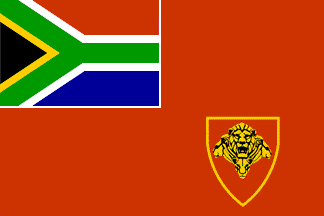 image
by Martin Grieve, 23 Mar 2004
image
by Martin Grieve, 23 Mar 2004
Following the adoption of new Army badge and rank insignia in March 2000 which resulted in the Castle of Good Hope outline being dropped, a new flag for the South African Army was introduced in April 2002. The Army new emblem comprises three conjoined lions' heads above one lionesses head (the so-called "pride of lions") in gold in the centre of a red shield. This design was never registered with the heraldic authorities due to a perceived resemblance to the design used by India as a national emblem which is derived from the so-called Ashoka Pillar.
ay02.gif) image
by Martin Grieve, 23 Mar 2004
image
by Martin Grieve, 23 Mar 2004
Consequent upon the adoption of the new army emblem, two new Army flags were introduced in April 2002. The new army emblem replaced the
springbok and castle outline in the fly of the Army flag. The lions represent cohesion and the
ongoing transformation of the Army within the SANDF. The use of this flag was short-lived and it was replaced a year later
(see above)
following the adoption of the new 9 pointed star outline by the SANDF.
Bruce Berry, 23 Mar 2004
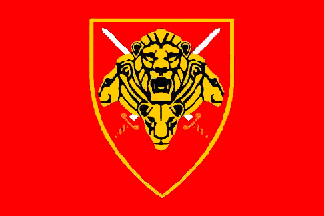 image
by Martin Grieve, 23 Mar 2004
image
by Martin Grieve, 23 Mar 2004
A new Army Office flag was also introduced in April 2002. This flag has a red field with the emblem superimposed over a pair of crossed swords
in the centre.
Bruce Berry, 23 Mar 2004
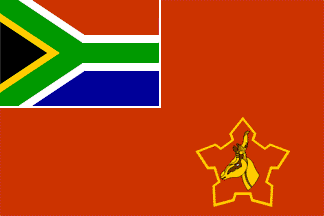 image
by Martin Grieve, 24 Mar 2004
image
by Martin Grieve, 24 Mar 2004
On 11 November 1994 new South African military flags was adopted. Among these
was a new flag of the South African National Defence Force (SANDF) which has a:
green field with the national flag in the canton, and emblem in the lower fly
(two swords, one anchor, and wings). The Army is similar but with a red field
with a Springbok head emblem
Jaume Olle, 24 Nov 1996
The flags of the SANDF are as described above but the Airforce has a gold
eagle in castle emblem. All these flags are based on the designs used by the
former South African Defence Force (SADF). All the defence force flags have the
national flag in the canton and the the emblem of the particular service (Army,
Air Force etc) in the fly with the exeption of the naval ensign, which does not
display any emblem. A history of the Flags of the Union Defence Forces and of
the South African Defence Force 1912 - 1993 is available as SAVA Journal
2/93 [hhs93].
Bruce Berry, 26 Nov 1996
Following the adoption of the new national flag on 27 April 1994, a new flag design for the South African Army was approved by the Chief of the
South African National Defence Force on 11 August 1994, namely: "a
rectangular chilli red flag in the proportions of two to three; within the upper hoist quarter the national flag of the Republic of South
Africa, with a white fimbriation; and in the lower fly quarter the emblem of the South African Army, to wit; on an orange ground plan of
the Castle of Good Hope, with a gold border, a gold springbok head couped at the neck".
With the exception of the new national flag in the canton, this flag identical to that used previously
by the South African Army and was carried for the first time at a Defence Force parade held in Pietersburg on 11 November 1994.
(Source: Berry, B and Watson, E, "Flags of the South African Department of Defence - 1994 and
beyond", Paper presented at the XX International Congress of Vexillology, Stockholm, July 2003).
Bruce Berry, 24 Mar 2004
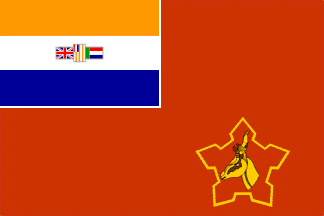 image
by Martin Grieve, 24 Mar 2004
image
by Martin Grieve, 24 Mar 2004In 1973, the design of the South
African Army flag was altered again. Uniform specifications as to
the badge were manifest. The gold springbok head couped at the neck was
centered on a gold outlined ground plan of the Castle of Good Hope. The
ground plan was the same orange as before. Also, a fimbriation was added
around the South African national flag. This design remained unaltered until 1994.
In 1994, the present design was approved on 11 August 1994 and presented
on 11 November 1994 which merely substituted the current
national
flag for the old one.
Sources: SAVA Journal 2/93, "Flags of the Union Defence Forces and
of the South African Defence Force, 1912-1993 [hhs93] ;" SAVA
Newsletter,
11/94."
Paige Herring, 12 Mar 1998
ay73.gif) image
by Martin Grieve, 24 Mar 2004
image
by Martin Grieve, 24 Mar 2004
There had been some confusion surrounding the design of the springbok head used by the South African military prior to 1973. To rectify this
position in so far as the Army was concerned, and also to avoid confusion with the designs of the shoulder-flashes worn by the various
members and commands, a new emblem for the South African Army was designed.
On 16 February 1973 a new flag for the South African Army was also approved, namely:
"A rectangular [permanent force] orange flag in the proportions of two to three; within the upper hoist quarter
the national flag of the Republic of South Africa, with a white fimbriation; and In the lower fly quarter the emblem of the South
African Army, to wit; On an orange ground plan of the Castle of Good Hope with a gold border, a gold springbok head couped at the neck".
When all the flags and emblems of the South African Defence Force were standardised in 1981, the Chief of the South African Defence Force
approved a design for the Army which was in fact a confirmation of the
design which was already in use. This flag was flown until the change in the Army flag with the adoption of the new national flag in 1994.
Bruce Berry, 24 Mar 2004
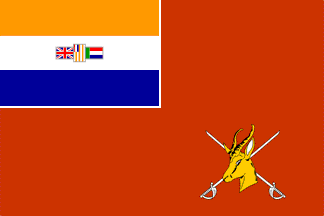 image
by Martin Grieve, 24 Mar 2004
image
by Martin Grieve, 24 Mar 2004
From 1966-1973, the second South African Army flag was flown. The regulations in 1966
added two crossed silver swords behind the head. This design encountered
many drawbacks as there were no design specifications; therefore, the flag
was not uniform when manufactured.
Paige Herring, 12 Mar 1998
ay66.gif) image
by Martin Grieve, 24 Mar 2004
image
by Martin Grieve, 24 Mar 2004
On 16 November 1966 the High Command of the South African Defence Force approved an amendment to the design of the Army emblem, such that the
springbok head should be placed in the front of two silver crossed swords.
The Army emblem was placed in the fly of a flag with the South African national flag in the canton with a [permanent force] orange field.
This version of the Army flag was used until the Army emblem was modified in 1973 (see above).
Bruce Berry, 24 Mar 2004
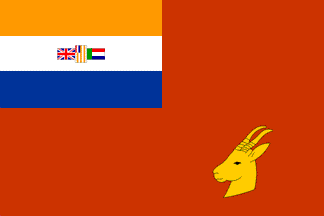 image
by Martin Grieve, 25 Mar 2004
image
by Martin Grieve, 25 Mar 2004
First adopted in 1951, there have been four versions of the South African
Army flag. The basic design has not changed. The general design is
a [sealed permanent force] orange field with the national flag in the canton.
Proportions have been 2:3. The first version had a gold springbok head
in the lower fly quarter. The size was 1/3 of the width. This version was
in effect from 1951-1966.
Paige Herring, 12 Mar 1998
ay51.gif) image by Martin Grieve, 25 Mar 2004
image by Martin Grieve, 25 Mar 2004
The first flag for the South African Army was created by Routine Order No. 1705 of 1951 and specified that it should be of the following
design: "a rectangular [sealed permanent force] orange flag in the proportions of two to three; within the upper hoist quarter the national
flag of the Union of South Africa; and in the lower fly quarter a gold springbok head, the height of which should be equal to one-third of the
width of the flag."
A special note on the colour used by the South African Army which is always called orange when in fact the exact shade is a more reddish
colour. Early in the history of the South African military it became
necessary to have a colour for various purposes and a reddish shade was selected which was distinct from the orange found in the then national
flag of South Africa. The chosen shade was then "sealed" by the defence
force authorities and thereafter became known as "sealed permanent force orange", originally identified as British Colour Council 97 (poppy). In
the 1970s this was changed to BCC98 (chilli).
Bruce Berry, 25 Mar 2004
As far as I know, the Castle of Good Hope is a fortress in Cape Town.
It is of great historical significance to South Africans as both a military
institution and as a part of its colonial history (it is the oldest building
in South Africa). It was erected by the Dutch East India Company and was
completed in 1679. According to the SAVA Journal that I got the information
out of, the Castle of Good Hope has and is still used for military administration.
Paige Herring, 16 Mar 1998
The ground plan of the Castle of Good
Hope was used as the outline for the emblems of the various constituent arms
of service of the South African National Defence Force before 2003. The
Castle of Good Hope is the oldest building in South Africa, having been erected
by the Dutch East India Company between 1665 and 1679. Since 1679 is has
been a seat of military administration of one kind or another, and thus it was
considered an appropriate device to be used on the various ensigns of the
defence force prior to the new SANDF emblem being adopted in 2003.
Bruce Berry, 09 Apr 2004
It was the Imperial Light Horse. When South Africa became a republic in 1964 the
badge had to change. The Royal Standard (viewer's left) became the national flag of South Africa. The Union Jack (viewer's right) became a horizontal bicolour (but
in one colour metal), and I can't remember what it is supposed to represent.
This was a Transvaal regiment, but it is not the Transvaal
flag. The scroll at the base of the flags until 1965 read "Imperium
et Libertas", and this changed to "Patria et Libertas".
There is a picture of the pre-1965 badge at this
site.
T.F. Mills, 18 May 2000